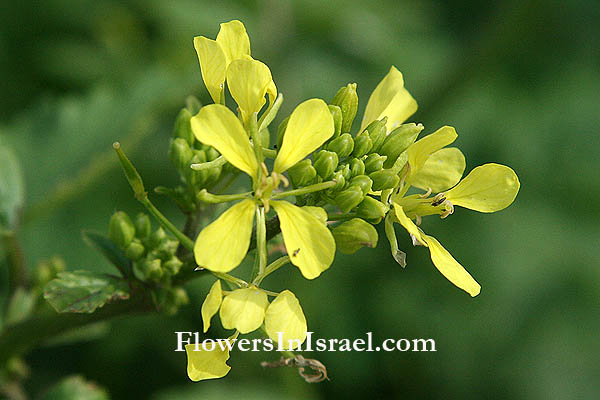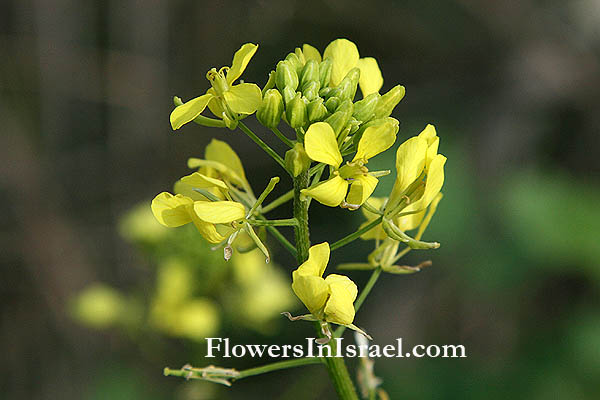Rhamphospermum arvense, Charlock, Charlock Mustard,
Corn Mustard, Corn-Mustard, Field Mustard, Wild Mustard,
Hebrew: חרדל השדה, Arabic: خردل
| Scientific name: | Sinapis arvensis L. | |
| Synonym name: | Brassica arvensis (L.) Rabenh., Eruca arvensis (L.) Noulet, Raphanus arvensis (L.) Crantz, Rhamphospermum arvense (L.) Andrz. ex Besser | |
| Common name: | Charlock, Charlock Mustard, Corn Mustard, Corn-Mustard, Field Mustard, Wild Mustard | |
| Hebrew name: | חרדל השדה | |
| Arabic name: | خردل | |
| Family: | Cruciferae / Brassicaceae, מצליבים |

|
| Life form: | Therophyte, annual | |
| Stems: | 20–120 cm high; erect, cylindrical, much branched; abundant white hairs that are long and straight, but slightly downward-pointing; often a reddish purple ring or patch at the junction of a new stem developing from an older stem; upper stems terminate in racemes of yellow flowers | |
| Leaves: | Alternate, dissected, dentate or serrate; upper leaves may clasp the stem, lower leaves have petioles and ovate, oblanceolate, or obovate in shape | |
| Flowers: | 4 Yellow petals, 6 stamens, and a single green pistil in the center | |
| Fruits / pods: | Silique tapers into a short beak; several fine nerves running along the length of its surface, which is slightly pubescent or hairless; seedpods, erect or spread outward, but they do not droop downward; tiny dark brown or black spherical seeds | Flowering Period: | January, February, March, April, May, December |
| Habitat: | Batha, Phrygana | |
| Distribution: | Mediterranean Woodlands and Shrublands, Semi-steppe shrublands, Deserts and extreme deserts, Montane vegetation of Mt. Hermon | |
| Chorotype: | Mediterranean | |
| Summer shedding: | Ephemeral |

Derivation of the botanical name: Sinapis, sinapi, Latin name for the mustard plant, from the flavor of the seeds. arvensis, arvum, field, cultivated land, plowed land; of cultvated fields. Brassica, the classical Latin name for cabbage. Erucaria, Latin, eruca, rocket, cruciformous herb; arius, Latin suffix, pertaining to. Raphanus, Greek raphanos, "quick-appearing" because of the rapid germination of the seeds. Rhamphospermum, rhamph- or rhampho- combining form Greek rhamphos, akin to rhabdos, rod : beak; spermum, seeded. The Hebrew name: חרדל, hardal Post Biblical Hebrew mustard; Aramaic-Syrian: חרדלא (=mustard); Arabic: hardal is probably a loan word.
Many have supposed that the charul (Greek, φρύγανα άγρία, similar to a term meaning "a rough dry stick") may probably be the Sinapis arvensis, which is a pernicious weed abounding in corn-fields. The word خردل khardul is applied in all old Arabic works, to species of mustard and it is not unlike the kharul or charul, of the Bible. Bible Resources:
|